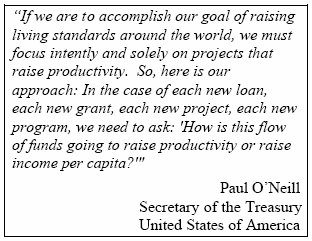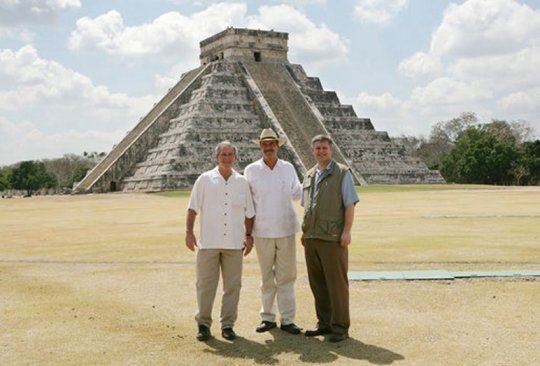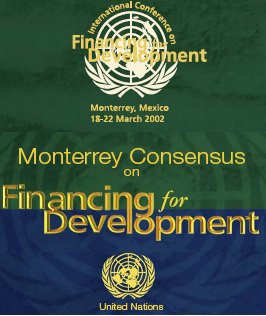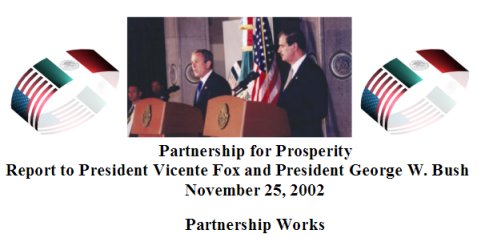The Trojan Triangle
Partnership for Prosperity (P4P)
![]()
Collusion, Treason, Grand Theft Country
"Among our highest priorities is unfettering the economic potential of every citizen, so each may contribute fully to narrowing the economic gaps between and within our societies."
~ President George W. Bush and President Vicente Fox February 16, 2001 ~
Presidents Bush and Vicente Fox will meet on
Feb. 16 at Mr. Fox's ranch, in Mr. Bush's first border crossing as
commander in chief.
They have more in common than a taste for cowboy boots and enchiladas.
Both have ideas that could transform the political and economic
relationship between the superpower and the striving nation to the
south.
''Our common border is no longer a line that divides us, but a region
that unites our nations, reflecting our common aspirations, values and
culture,'' the secretary of state, Gen. Colin L. Powell, said today
in Washington at his first news conference, held jointly with the new
Mexican foreign minister, Jorge Casteñeda.
Seeing the border as a symbol of unity, calling Mexico and the United
States next-door neighbors with common needs and intertwined fates, has
been long been Mr. Fox's political refrain. It is a fairly new tune for
American foreign policy, but the changes, symbolic and substantial, are
already happening.
Mr. Bush wants to greatly expand trade across the border, calling commerce ''the long-term solution'' for illegal immigration. Both presidents say that if Mexico's economy becomes stronger, fewer Mexicans will head north looking for work.
''The thing that really has to be done to solve this problem is to continue to help the Mexican economy grow, so that jobs are in the south, so that the great magnet is no longer just in the north, but it is also within Mexico,'' General Powell said today.
The goal should be to let them ''come into America legally to work, have their rights protected and accumulate human and financial capital to take back to Mexico,'' said Sen. Phil Gramm, a Texas Republican.
Mr. Bush and Vice President Dick Cheney have been talking for months about the need for a hemispheric energy policy -- ''an approach that looks at all of North America as one giant market,'' as Mr. Cheney put it. If both sides agree, the United States could invest in Mexican power plants and get cheap electricity in return.
All this is music to Mr. Fox's
politically attuned ears. He wants it all to happen -- and more, much
more. In time, he says, the two nations can be so integrated,
economically and politically, that the border would be more like the
common wall of adjoining homes and less like a militarized frontier.
It may not be that wild an idea. Mexico is ''the house next door,''
Mr. Greenspan argued at a closed meeting of the Federal Open Market
Committee in 1995, when Mexico's economy was near collapse and the Fed
stepped in with a multibillion-dollar bailout.
On February 16, 2001, George Bush and Vincente Fox met Guanajuato, Mexico. Following the February 16th meeting between Bush and Fox, a joint communiqué was issued.
Excerpts:
Toward a
Partnership for Prosperity
The
Guanajuato Proposal
Among our highest priorities is unfettering the economic potential of every citizen, so each may contribute fully to narrowing the economic gaps between and within our societies. We acknowledge the dynamism achieved through NAFTA, which has ushered in dramatic increases in trade that have transformed our economic relationship. After consultation with our Canadian partners, we will strive to consolidate a North American economic community whose benefits reach the lesser-developed areas of the region and extend to the most vulnerable social groups in our countries. To this end, we support policies that result in sound fiscal accounts, low inflation, and strong financial systems.
Migration is one of the major ties that bind our societies. It is important that our policies reflect our values and needs, and that we achieve progress in dealing with this phenomenon. We believe that Mexico should make the most of the skills and productivity of their workers at home, and we agree there should be an orderly framework for migration which ensures humane treatment, legal security, and dignified labor conditions. For this purpose, we are instructing our Governments to engage, at the earliest opportunity, in formal high-level negotiations aimed at achieving short and long-term agreements that will allow us to constructively address migration and labor issues between our two countries. This effort will be chaired by the Secretary of State and the Attorney General of the U.S. and the Secretary of Foreign Relations and the Secretary of the Interior of Mexico.
We attach the utmost importance to issues affecting the quality of life along our common border. We shall work for the economic and social development of our border communities, fight violence and strive to create a safe and orderly environment. We will form a new high level working group under the auspices of the Binational Commission to identify specific steps each country can take to improve the efficiency of border operations. We will begin immediate discussions to implement the NAFTA panel decision on trucking.
We will consult
with our NAFTA partner Canada regarding development of a North American
approach to the important issue of energy resources. Building on the
strength of our respective cultures, we will seek to expand our
partnership broadly in ways that help secure a better future for our
people. Education is a key to that future; we will increase exchanges
and internships that help develop human capital, and promote respect
for each other's rich cultural heritage. We will seek new cooperation
in science, technology, and the environment, on which much of our
economic progress and our people's well being will depend.
Beyond the bilateral agenda, our two Governments are also ready to
discuss regional and hemispheric issues important to both our nations.
The Summit of the Americas, to be held in April in Quebec City, will
provide a valuable forum in which the hemisphere's democracies can
address and advance shared goals of strengthening democratic
institutions and stimulating economic prosperity through free trade
and education. We reaffirm our support for the creation of a Free
Trade Area of the Americas as soon as possible.
On June 22, 2001 the U.S. State Department issued a joint communiqué concerning Mexican migration: (Excerpts)
Presidents Vicente Fox and George W. Bush,
in the "Guanajuato Proposal" issued following their meeting in February,
characterized migration as one of the major ties that bind Mexico and
the United States. Accordingly, our respective policies should work to
create a process of orderly migration that guarantees humane treatment
of migrants, provides protection of their legal rights,
ensures acceptable work conditions for migrants and also recognizes the
right of nations to control the flow of people across their borders.
The initial meeting of the High Level Working Group on Migration occurred in Washington, DC on April 4. The two sides began talks aimed at achieving the goal of safe, legal, orderly and humane migration as set forth by our Presidents in Guanajuato. The binational agenda includes discussion of border safety, the H-2 temporary worker visa program, ideas on regularization of undocumented Mexicans in the United States, alternatives for possible new temporary worker programs, and efforts on regional economic development.
Plan of Action
I. National and Binational Programs for Migrant Safety
Develop a comprehensive set of binational programs and actions in areas of immediate concern to eliminate extreme risks to migrants. The deserts in Western Arizona, the All American Canal and the Rio Grande should be a priority in this regard.
Strengthen public safety campaigns in Mexico to alert potential migrants of the imminent dangers of crossing the border through high-risk areas.
Develop and implement specific operational plans for the search and rescue of migrants in dangerous areas along the border.Reinforce training programs on safety and migrant search and rescue operations.
Map high-risk areas along the border to have an accurate portrait of new routes and implement preventive actions to reduce migrant risks.
Activate additional cooperative binational actions on both sides of the border, like operations "Sky Watch II" -- a programs of aerial surveillance in the Arizona desert -- along with the reinforced presence of Beta Group elements in the Mexican side.
Schedule periodic meetings, as needed, with Mexican and U.S. border consulates and law enforcement authorities to review regularly the results and the progress of local coordination efforts on border safety.
III. Border Violence
Implement the U.S.-Mexico Memorandum of Understanding on Cooperation against Border Violence (Mérida, February 15, 1999) and corresponding Guidelines (Washington, June 8, 2000) for cooperation between Mexican consuls and U.S. Attorneys in the border region. These memoranda facilitate the investigation of diverse violent incidents occurring at the border.
Initiate a pilot program on use of non-lethal weapons by Border Patrol agents.
Strengthen bilateral cooperation on preventive actions in order to:
Reduce incidents of aggression against Border Patrol agents;
Prevent assaults against migrants and border authorities;
Deter migrant detentions by civilians.
V. Cooperative Responses to Border Region Emergencies
Agree on a Rapid Response Program that guarantees early alert and information exchanges between authorities of both governments for the immediate attention to critical border incidents.
Such a program should aim to coordinate actions between central (Washington-Mexico City) and local authorities (Mexican consul-INS/BP) including measures to ensure that proper investigations are conducted.
Develop cooperative mechanisms to respond to emergencies at the border, such as Emergency Management and Response Mechanisms:At border crossing points and international bridges in cases of bomb threats or trans-border pursuit of criminals.
During weather related and natural disaster emergencies (wild fires, snow storms, rainstorms, heat waves,) for search and rescue coordination, publication of weather advisories, etc.Enhance coordination to attend to injured persons during emergencies:
Consider installation of dedicated telephone alarm system tied to emergency services
On September 6, 2001, Vincente Fox addressed the U.S. Congress. Information on this speech and the implications of it are documented HERE.
Also on September 6, 2001, the White House issues a press release on the 'Partnership for Prosperity':
Fact Sheet: Partnership for Prosperity
Forming a "Partnership for Prosperity": To help address some of the root causes of migration, Presidents Bush and Fox have agreed to form a public-private alliance to spur private-sector economic growth throughout Mexico. This "Partnership for Prosperity" -- led on the U.S. side by Deputy Secretary of the Treasury Kenneth Dam and Under Secretary of State Alan Larson, and on Mexico's side by Under Secretary Augustin Carstens and Under Secretary of Foreign Relations Miguel Hakim -- would draw upon the best ideas of U.S. and Mexican economists, businesspeople, development experts, and policymakers.
Importantly, this partnership would focus on ways to promote private sector growth beyond the border. Examples of the types of opportunities that could be explored include:
Promoting U.S. direct investment in Mexico, with special emphasis on small and mid-sized businesses;
Assisting all regions of Mexico to develop a capacity to attract private investment;
Promoting investment in infrastructure;
Creating jobs and facilitating increased efficiency for small and medium-sized businesses through use of communications technology to create new and improved linkages between customers and suppliers; and
Identifying ways for existing programs, such as those of the Export-Import Bank and the multilateral institutions, to play a more effective role in Mexican economic development.
Presidents Bush and Fox have asked this group to report back with a concrete action plan by March 2002.
This effort should complement -- not supplant -- the many fruitful ways in which the United States and Mexico are working together in other areas, including enhancing our trade relationship; promoting macroeconomic stability; addressing migration and labor issues; protecting the environment, particularly along our border; and cooperating in the fight against drug trafficking, drug abuse, and organized crime.
In March of 2002, an international conference was held in Monterrey Mexico concerning cross-border banking and financial programs for the development of Mexico.

Fact Sheet
The White House, Washington, DC
March 22, 2002
U.S.-Mexico Partnership for Prosperity
Origins of the U.S.-Mexico
Partnership for Prosperity
When they first met as Presidents, in February 2001, President Bush and
President Fox explained that, 'Among our highest priorities is
unfettering the economic potential of every citizen, so each may
contribute fully to narrowing the economic gaps between and within our
societies.'
In September of 2001, during President Bush's first state visit,
President Bush and President Fox took an important step toward realizing
that vision. They launched the Partnership for Prosperity, a
private-public alliance to harness the power of the private sector to
foster an environment in which no Mexican feels compelled to leave his
home for lack of jobs or opportunity.
After six months of work, the Partnership has produced a concrete action
plan. The plan draws upon the best ideas emerging from two conferences
(one in Merida, Mexico and one in Washington, D.C.) attended by over one
hundred experts from the private and public sectors. The Partnership has
been led in the United States by Deputy Treasury Secretary Kenneth Dam
and Under Secretary of State Alan Larson.
Leveraging the Resources and Expertise of the Private Sector
The action plan builds on the President's New Compact for Development. As President Bush said last week before the Inter-American Development Bank, "Most of the money for development does not come from aid. It comes from domestic investment, foreign direct investment, and, especially, from trade." The action plan, therefore, seeks to leverage private sector resources and expertise.
Action Plan
The action plan includes projects to facilitate investment in small
business, housing, agriculture, roads, ports, airports, and information
technology.
Specific examples include:
Increasing investment in housing.
The U.S. Treasury Department will coordinate the provision of technical assistance to Mexico's Sociedad Hipotecaria Federal (SHF) to encourage securitization of mortgages and the creation of a secondary mortgage market in Mexico. In these efforts, Treasury will draw upon experts with experience in housing finance from private financial institutions, government-sponsored agencies (like Fannie Mae, Freddie Mac, and Ginnie Mae), and the U.S. Office of Federal Housing Enterprise and Oversight (OFHEO).
Investing in infrastructure for commerce.
The Partnership will lead an effort to spur the participation of U.S. companies in the development of Mexican infrastructure projects including: ports, an air cargo facility, and an expansion of Mexico's internet connectivity.
Financing U.S. franchise opportunities for Mexican entrepreneurs.
A U.S. franchise can be more than a brand-name, it can also be a set of best practices. As U.S. businesses share more of their business practices, technology, and distribution systems with Mexican entrepreneurs, productivity in the Mexican economy will rise.
Supporting small businesses in Mexico.
The Partnership, through the Small Business Administration and other agencies, will provide assistance in establishing small business development centers in Mexico to promote entrepreneurial competitiveness.
Lowering the cost of sending money home.
Last year, Mexicans and Mexican-Americans in the U.S. sent $9.3 billion home to family and friends in Mexico. But they paid high fees to do so. More competition in financial services will lower the fees and help make sure that more money gets to the people who need it most and helps strengthen regional economies. Also, U.S. Treasurer Rosario Marin will work to highlight awareness of competitive products by promoting financial literacy and expanded use of the banking system by American Hispanics.
This one, you have to see because it includes lots of pictures and quotes and programs listed... HERE

![]()
June 17, 2010

